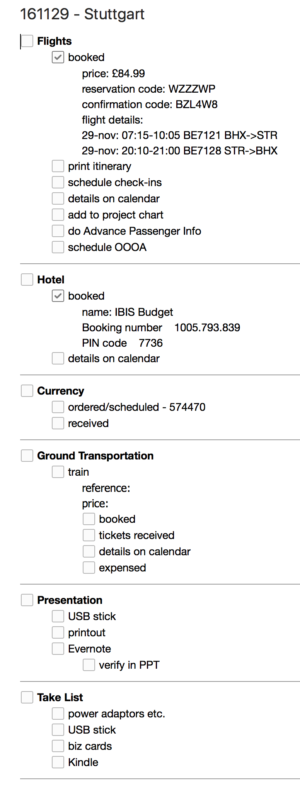Using Evernote
As it is a software tool [or a service, depending on how you look at it], that I use many times every day, it is surprisingly long since I last wrote about Evernote. Overall, the benefit that I gain from using Evernote is a very flexible operating environment. I can work on my desktop computer [iMac] in my home office. Then, without really making any preparations, I can grab the MacBook and continue my work elsewhere. To a significant extent I can do this with my iPad and my iPhone as well. At a stretch, I could even work at any Internet-connected computer using a browser to access Evernote.
There is almost no limit to the number of applications I find for Evernote, but I would like to highlight a few …
The broad concept of Evernote is the idea of a “note”. This is a document that can contain text [formatted or not] and images. Any number of other files, of any type, may be attached to a note. Notes may be grouped into notebooks, which, in turn, may be grouped into stacks. Along with tagging and powerful search facilities, Evernote provides a very flexible way to store and easily retrieve a variety of data. There are lots of ways that Evernote can be used and there is much discussion about which approach is “best”. I have evolved the way I use Evernote in the 5 or 6 years since I first tried it and now tend to use quite a large number of notebooks, grouped into a few stacks. Each notebook typically holds a minimal number of notes. Many of my notebooks have a companion, with the prefix “old” on their name, into which I drop notes for which I have no further immediate use, but do not want to trash. They are, thus, available if I want them, but do not clutter my workspace.
Here are some examples of my notebooks:
 Books [actually I have 2 notebooks, one for unread and the other for read books]. Each time I acquire a new book [usually on Kindle], I create a note and copy the “blurb” from Amazon. The note is tagged “fiction”, “non-fiction” or “biography”; a few notes, which are for books I plan to read soon are tagged “hot books”. I use the note to record notes after I read it, which find their way into a blog.
Books [actually I have 2 notebooks, one for unread and the other for read books]. Each time I acquire a new book [usually on Kindle], I create a note and copy the “blurb” from Amazon. The note is tagged “fiction”, “non-fiction” or “biography”; a few notes, which are for books I plan to read soon are tagged “hot books”. I use the note to record notes after I read it, which find their way into a blog.
Recipes. I do quite a lot of cooking, a lot of which I can do without instruction. But I do use recipes sometimes, of course. I usually find recipes online and, if I like one, make an Evernote note. I use a “vegetarian” tag to help me find such recipes. Otherwise I just use the search facilities to look for what I need. Sometimes, when I am preparing a meal, I create a note in my Scratch notebook and copy in the recipes. I then add checkboxes, timings and maybe a shopping list.
Travel. I have a standard, comprehensive template note for when I am traveling on business. It has checkboxes for everything and places to note details. I make a copy for each trip and complete it as I make arrangements. Relevant documents, like itineraries, boarding passes etc., are attached and are, thus, immediately to hand. I do the same thing for personal travel – just make a few modifications to the note, as required. When I am on business, I have another note in my Expenses notebook for each trip, where I note my expenditure and attach receipts etc.
Events. I often participate in business events – conferences, trade shows, online seminars etc. Each one has its own note, where I keep all the contact details, web links, schedules. I also attach all of my materials – papers and presentations. So, I just need to open the event note on my MacBook or iPad [or even iPhone] and I am ready to make my presentation.
Hopefully this gives a flavor of why and how I use Evernote. Although I am an enthusiast for the product/company, I have no business interest in them. I am always on the lookout for alternatives, as there might be something even better out there. Microsoft OneNote is the best option, but it has a few limitations at the moment. My reservation with Evernote is mainly with the company, who sometimes take their time fixing little bugs in the apps and I am unsure of their long term viability. I try to remain open minded.